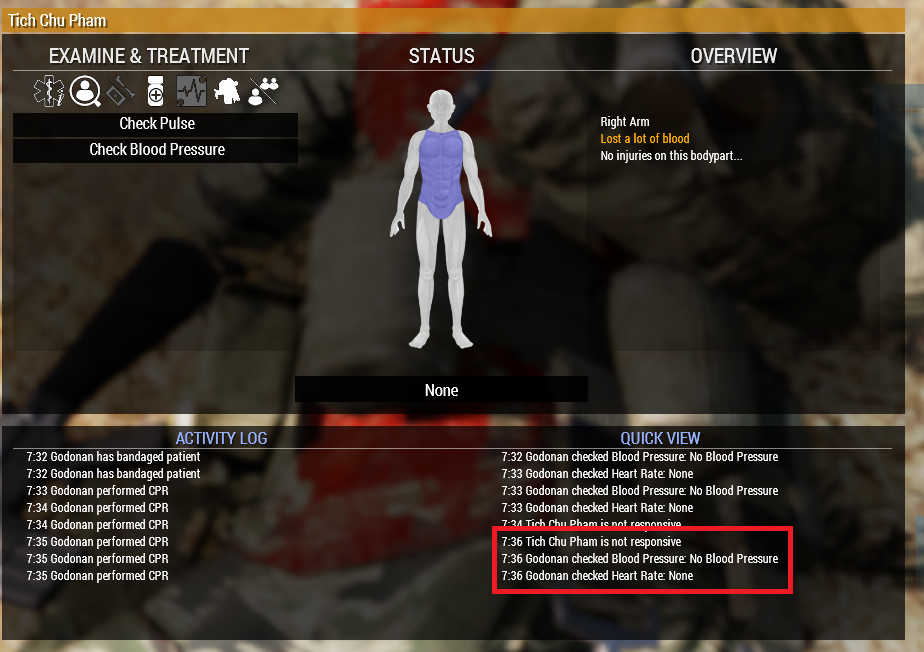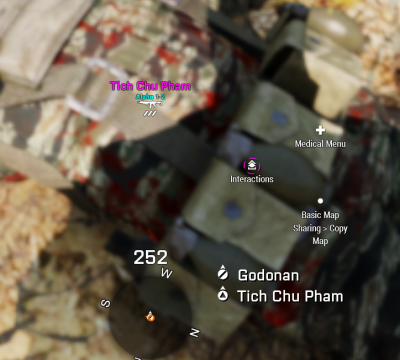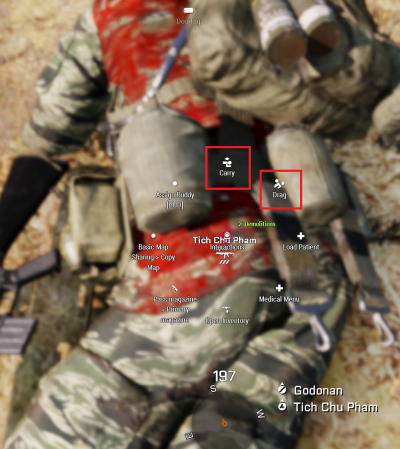Difference between revisions of "A3 Legacy Medical Information"
Views
Actions
Namespaces
Variants
Tools
m |
|||
| (18 intermediate revisions by 5 users not shown) | |||
| Line 1: | Line 1: | ||
== | == '''This page is a legacy page archived for use as a reference to rebuild the page for Reforger when the time comes.''' Also to avoid confusion for new players seeing the new infantry guide link here. == | ||
This document is intended as an introduction to the "All Members Course" of TCCC and Coalition's Basic Medical Functions. | |||
=Tactical Combat Casualty Care (TCCC)= | |||
''' | '''Individually you are Supplied;''' | ||
*2x elastic bandages best used for avulsions, lacerations and crushed tissues. '''See figure X''' | |||
*2x packing bandages best used for penetrating injuries. '''See figure Y''' | |||
*1x tourniquet for wounds you intend to address but dont have sufficient bandages to do so. '''See figure Z''' | |||
**Note, tourniquets will arrest all blood loss from the limb it is applied to. Thus it belays the need to be bandaged immediately. Despite this, if you sustain a lower limb injury it will hinder further movement until that wound is properly bandaged. Similarly broken or wounded arms merely stemmed with a tourniquet will hinder aim and weapon manipulation. Consider this when conserving medical equipment. | |||
**Further, tourniquets will induce pain if left on for too long. If you remove a tourniquet it returns to your inventory, so if the medic removes it it is in their inventory. Retain your tourniquets if at all possible in the event you're wounded again. | |||
'''Individual Care Under Fire''' | |||
As general infantry your first actions on sustaining an injury must be to return overwhelming fire. For the minor inconvenience of an avulsion or a simple penetrating injury you may individually bandage and continue on course - however in more serious cases aggressive action may be needed. If either you or one of your team is downed under contact the following actions will diminish casualties. | |||
*First, take cover and suppress the enemy with overwhelming fire. | |||
*Second, if applicable see to your wounds with what equipment you carry for individual use. | |||
*If you are not wounded but your team-mate is, maintain security while they treat their wounds. If they are unconscious ensure they are in a safe location and tourniquet what you can to delay their bleed-out. | |||
*Finally, contact your direct superior (Team-lead, Squad-lead etc) and notify them of the casualty. Depending on the severity and extent of the injury they may need to incorporate a medic. | |||
=The Role of Casualty Collection Points, Field Hospitals, & Medical Personnel= | |||
'''Medical Facilities''' | |||
Casualty Collection Points (CCP) and Field Hospitals (FH) are integral to the Coalition Medical System. CCP's are intended to act as forward triage centres and are often, but not always, available to squad medics. Field Hospitals are intended to provide the platoon or company with more advanced medical interventions and equipment. To some degree each of these may be called upon for the deployment of reinforcements - either as a point of respawn or as a request for reinforcement waves via the structure's ace-interaction. '''See figures XAZ and XBZ''' | |||
''' | |||
Upon entering the Casualty Collection Point or Field Hospital your medical capabilities/permissions in-game are promoted one notch. So for general infantry they increase to the capabilities of a medic, for medics to a doctor, etc. Further details on Coalition™ Advanced Medical is discussed '''here'''. | |||
'''The Employment of Medical Facilities''' | |||
CCPs are deployed using ACE self interact. When you have deployed your CCP, it will resemble a pile of back packs. In this state, it can be repacked and moved to a more advantageous location as needed. Once you have unpacked the CCP and it transforms into a MASH tent, you can no longer move it or take it down. You only get one CCP per medic so be mindful of where and when it is deployed. | |||
CCPs are deployed using ACE self interact. When you have deployed your CCP, it will resemble a pile of back packs. In this state, it can be repacked and moved to a more advantageous location. Once you have unpacked the CCP and it transforms into a MASH tent, you can no longer move it or take it down. You only get one CCP per medic so be | |||
Once you've built your CCP and it's in it's final tent form, you can use the action menu inside the tent to request a reinforcement wave. Once you've done this, the admins will take note, assign roles to currently dead players, and then respawn them at the CCP. It will be your job as the medic to make sure they're reasonably organized and ready to fight. Coordinate with command elements to get reinforcements to the front line effectively, don't let them out of your sight until you've got a plan for them. | Once you've built your CCP and it's in it's final tent form, you can use the action menu inside the tent to request a reinforcement wave. Once you've done this, the admins will take note, assign roles to currently dead players, and then respawn them at the CCP. It will be your job as the medic to make sure they're reasonably organized and ready to fight. Coordinate with command elements to get reinforcements to the front line effectively, don't let them out of your sight until you've got a plan for them. | ||
As of the implementation of the advanced medical system, CCPs are crucial in providing surgical care on the front. Once the field hospital is place, the CCPs act as your forwards surgery points. | As of the implementation of the advanced medical system, CCPs are crucial in providing surgical care on the front. Once the field hospital is place, the CCPs may act as your forwards surgery points. | ||
'''Responsibilities of Squad Medics''' | |||
' | It's expected that medics stay alive. In much the same fashion that command personnel should stay alive to continue commanding, it is imperative medics stay alive. If we lose our medic we lose our ability to: | ||
*Treat Pain | |||
*Treat blood loss | |||
*Build Casualty Collection Points (CCP) or Field Hospitals (FH) | |||
*Provide surgery and medevac | |||
*Request reinforcements | |||
*Remain an effective fighting force | |||
Considering this the medic must focus on providing medical care first and foremost while keeping their exposure in mind. Staying alive means the general infantry stay alive which is ultimately mission critical. | |||
'''Responsibilities of the Medical Officer''' | |||
*The medical officer is the only person who can place the Field Hospital and access the medical transport vehicle. | |||
*Placement of the field hospital provides surgery kits with which to return personnel to 100% health. | |||
**Surgery kits may be used in either the CCP or FH. | |||
*The medical officer works with other medics and medevac crews to provide medical attention in the field. | *The medical officer works with other medics and medevac crews to provide medical attention in the field. | ||
*Ultimately this is a position of responsibility, it is not a combat position. Take if you want to facilitate the survival of your friends, not necessarily if you want to shoot people. | |||
* | |||
'''The Field Hospital and the Medical Vehicle''' | '''The Field Hospital and the Medical Vehicle''' | ||
The | The Field Hospital is the central medical collection point in any mission. It is a large tent that usually spawns with a faction specific medical vehicle. This vehicle should be used to keep the medics and medical officer safe, transport patients, and occasionally assist in logistics operations. | ||
The Field Hospital is the only available source of surgery kits, so the Medical Officer will generally be forced to place it early enough in the mission that it will eventually be abandoned. | |||
It's up to medics to gather supplies from the Field Hospital and transfer care to CCPs and their squad-medics. It's recommended that you use the medical vehicle to gather supplies if more are required. | |||
=Pronouncing Death= | |||
The canon method of declaring the death of a patient is to use the ACE Medical menu to confirm that said patient: | |||
*Is not Responsive | |||
*Has no Blood Pressure | |||
*Has no Heart Rate | |||
'' | However, in ''extremely'' rare circumstances, the readings are deceptive, and the patient is, in fact, still alive. This can be induced if drugs such as morphine is still present in their system. Their alive status is confirmed by the presence of a drag/carry ACE interaction option. This option never appears on dead bodies. This possibility is demonstrated in the pictures below. | ||
Because of the potential for inconsistencies, always check if the body is draggable. If you want, you can go through the motions for checking the patient response, heart rate, and blood pressure. Don't call a still-living teammate dead! | |||
[[File:No_response.png|1000px|thumb|center|ACE Medical demonstrating no response, no heart rate, and no blood pressure. Patient is still alive, however.]] | |||
[[File:Not_draggable.png|400px|thumb|What interactions a dead patient would have. Not draggable.]] | |||
[[File:Draggable_body.png|400px|thumb|left|Patient is still draggable, and thus still alive.]] | |||
Latest revision as of 18:31, 12 June 2024
This page is a legacy page archived for use as a reference to rebuild the page for Reforger when the time comes. Also to avoid confusion for new players seeing the new infantry guide link here.
This document is intended as an introduction to the "All Members Course" of TCCC and Coalition's Basic Medical Functions.
Tactical Combat Casualty Care (TCCC)
Individually you are Supplied;
- 2x elastic bandages best used for avulsions, lacerations and crushed tissues. See figure X
- 2x packing bandages best used for penetrating injuries. See figure Y
- 1x tourniquet for wounds you intend to address but dont have sufficient bandages to do so. See figure Z
- Note, tourniquets will arrest all blood loss from the limb it is applied to. Thus it belays the need to be bandaged immediately. Despite this, if you sustain a lower limb injury it will hinder further movement until that wound is properly bandaged. Similarly broken or wounded arms merely stemmed with a tourniquet will hinder aim and weapon manipulation. Consider this when conserving medical equipment.
- Further, tourniquets will induce pain if left on for too long. If you remove a tourniquet it returns to your inventory, so if the medic removes it it is in their inventory. Retain your tourniquets if at all possible in the event you're wounded again.
Individual Care Under Fire
As general infantry your first actions on sustaining an injury must be to return overwhelming fire. For the minor inconvenience of an avulsion or a simple penetrating injury you may individually bandage and continue on course - however in more serious cases aggressive action may be needed. If either you or one of your team is downed under contact the following actions will diminish casualties.
- First, take cover and suppress the enemy with overwhelming fire.
- Second, if applicable see to your wounds with what equipment you carry for individual use.
- If you are not wounded but your team-mate is, maintain security while they treat their wounds. If they are unconscious ensure they are in a safe location and tourniquet what you can to delay their bleed-out.
- Finally, contact your direct superior (Team-lead, Squad-lead etc) and notify them of the casualty. Depending on the severity and extent of the injury they may need to incorporate a medic.
The Role of Casualty Collection Points, Field Hospitals, & Medical Personnel
Medical Facilities
Casualty Collection Points (CCP) and Field Hospitals (FH) are integral to the Coalition Medical System. CCP's are intended to act as forward triage centres and are often, but not always, available to squad medics. Field Hospitals are intended to provide the platoon or company with more advanced medical interventions and equipment. To some degree each of these may be called upon for the deployment of reinforcements - either as a point of respawn or as a request for reinforcement waves via the structure's ace-interaction. See figures XAZ and XBZ
Upon entering the Casualty Collection Point or Field Hospital your medical capabilities/permissions in-game are promoted one notch. So for general infantry they increase to the capabilities of a medic, for medics to a doctor, etc. Further details on Coalition™ Advanced Medical is discussed here.
The Employment of Medical Facilities
CCPs are deployed using ACE self interact. When you have deployed your CCP, it will resemble a pile of back packs. In this state, it can be repacked and moved to a more advantageous location as needed. Once you have unpacked the CCP and it transforms into a MASH tent, you can no longer move it or take it down. You only get one CCP per medic so be mindful of where and when it is deployed.
Once you've built your CCP and it's in it's final tent form, you can use the action menu inside the tent to request a reinforcement wave. Once you've done this, the admins will take note, assign roles to currently dead players, and then respawn them at the CCP. It will be your job as the medic to make sure they're reasonably organized and ready to fight. Coordinate with command elements to get reinforcements to the front line effectively, don't let them out of your sight until you've got a plan for them.
As of the implementation of the advanced medical system, CCPs are crucial in providing surgical care on the front. Once the field hospital is place, the CCPs may act as your forwards surgery points.
Responsibilities of Squad Medics
It's expected that medics stay alive. In much the same fashion that command personnel should stay alive to continue commanding, it is imperative medics stay alive. If we lose our medic we lose our ability to:
- Treat Pain
- Treat blood loss
- Build Casualty Collection Points (CCP) or Field Hospitals (FH)
- Provide surgery and medevac
- Request reinforcements
- Remain an effective fighting force
Considering this the medic must focus on providing medical care first and foremost while keeping their exposure in mind. Staying alive means the general infantry stay alive which is ultimately mission critical.
Responsibilities of the Medical Officer
- The medical officer is the only person who can place the Field Hospital and access the medical transport vehicle.
- Placement of the field hospital provides surgery kits with which to return personnel to 100% health.
- Surgery kits may be used in either the CCP or FH.
- The medical officer works with other medics and medevac crews to provide medical attention in the field.
- Ultimately this is a position of responsibility, it is not a combat position. Take if you want to facilitate the survival of your friends, not necessarily if you want to shoot people.
The Field Hospital and the Medical Vehicle
The Field Hospital is the central medical collection point in any mission. It is a large tent that usually spawns with a faction specific medical vehicle. This vehicle should be used to keep the medics and medical officer safe, transport patients, and occasionally assist in logistics operations.
The Field Hospital is the only available source of surgery kits, so the Medical Officer will generally be forced to place it early enough in the mission that it will eventually be abandoned.
It's up to medics to gather supplies from the Field Hospital and transfer care to CCPs and their squad-medics. It's recommended that you use the medical vehicle to gather supplies if more are required.
Pronouncing Death
The canon method of declaring the death of a patient is to use the ACE Medical menu to confirm that said patient:
- Is not Responsive
- Has no Blood Pressure
- Has no Heart Rate
However, in extremely rare circumstances, the readings are deceptive, and the patient is, in fact, still alive. This can be induced if drugs such as morphine is still present in their system. Their alive status is confirmed by the presence of a drag/carry ACE interaction option. This option never appears on dead bodies. This possibility is demonstrated in the pictures below.
Because of the potential for inconsistencies, always check if the body is draggable. If you want, you can go through the motions for checking the patient response, heart rate, and blood pressure. Don't call a still-living teammate dead!


